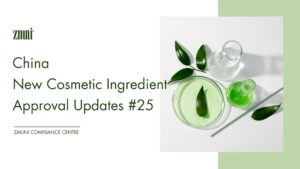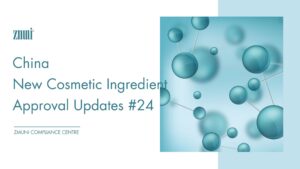+86 571 8659 2517
+86 180 5841 8258
info@zmuni.com

Recently, Cosmoprof Asia 2025 and Cosmopack Asia 2025 concluded successfully in Hong Kong. This year's event brought together 2,688 exhibitors from 46 countries and regions, showcasing innovations across skincare, makeup, fragrance, hair-care, nail products, and the full beauty supply chain. Spanning over 120,000 m², the exhibition demonstrated its strong international presence, with nearly 90% of exhibitors coming from outside Hong Kong. According to the organizers, the show welcomed over 70,000 professional visitors from Europe, the Americas, the Middle East, North Africa, and the Asia-Pacific region. Exhibitors from Southeast Asia and South Asia were particularly active, reflecting the energy

On November 18, 2025, China's National Center for Food Safety Risk Assessment (CFSA) issued a public consultation on 8 new food ingredients. The consultation is open until December 18, 2025, and comments or suggestions can be submitted to the official email address: xspyl@cfsa.net.cn. The proposed new food ingredients are:(Note: The first three ingredients have already been approved previously and are included in this consultation for adjustments.) Peony seed oil Nekemias grossedentata leaf polyphenols Cyclocarya paliurus leaf polyphenols L-Theanine(fermentation) Mycoprotein from Fusarium compactum Auxenochlorella pyrenoidosa (formerly Chlorella pyrenoidosa) Plant sterol

As China approaches the start of its 15th Five-Year Plan, the cosmetics industry is expected to enter a new stage of growth and transformation. This newly released Opinions serves as an important guide and reference for the development of China's cosmetics market over the next five years. On November 17, 2025, China's National Medical Products Administration (NMPA) officially released the final version of the Opinions on Deepening Cosmetics Regulatory Reform and Promoting High-Quality Development of the Industry. The draft of this document was publicly released for comments in September 2025. The Opinions introduces 24 reform measures across five key

On November 17, 2025, China's National Institutes for Food and Drug Control (NIFDC) has released 3 draft cosmetic standards for public consultation. The public consultation period will remain open until December 12, 2025. The drafts include newly added prohibited ingredients, as well as updates to maximum limits and usage restrictions for permitted preservatives and hair dyes. Detailed standards are as follows: No. Name Current Requirements Proposed Changes 1 Mercury and its compounds • Mercury and its compounds are listed as prohibited ingredients under Table 1 of the Safety Technical Standards for Cosmetics (STSC), except for two phenylmercury salts (phenylmercuric borate and thimerosal)

From November 11 to 17, 2025, 7 new cosmetic ingredients (NCIs) were notified with the China National Medical Products Administration (NMPA). The technical requirements for the 7 new cosmetic ingredients mentioned above have not been disclosed, and they have not yet entered the safety monitoring period; five of the seven are plant-derived ingredients. Pentyl 3-glyceryl Ascorbate Pentyl 3-glyceryl Ascorbate is a vitamin C derivative. During its development, SEIWA KASEI leveraged advanced molecular design to modify the chemical structure and significantly enhance the ingredient's stability, effectively addressing the long-standing issue of vitamin C's susceptibility to oxidation. SEIWA KASEI holds a dominant position in

From November 1 to 10, 2025, 4 new cosmetic ingredients (NCIs) were notified with the China National Medical Products Administration (NMPA). The technical requirements for the 4 new cosmetic ingredients mentioned above have not been disclosed, and they have not yet entered the safety monitoring period. Bicyclic Octapeptide-68 Bicyclic Octapeptide-68 is the first bicyclic peptide introduced to the cosmetic industry in China and worldwide. Compared with traditional linear peptides, bicyclic peptides offer greater stability and lower irritation, making them a highly promising class of actives. Proya Cosmetics Co., Ltd. is a leading Chinese beauty company with strong capabilities in R&D, manufacturing, and brand

On October 31, Chinese authorities including the Ministry of Finance, Ministry of Commerce, Ministry of Culture and Tourism, General Administration of Customs, and State Taxation Administration jointly issued the Notice on Improving Duty-Free Store Policies to Support Consumption. Effective November 1, 2025, the policy aims to further stimulate consumption and promote the healthy development of duty-free retail. The updated policy expands product categories in duty-free stores, adds more portable consumer goods, including mobile phones, mini drones, sports goods, health foods, over-the-counter medicines, and pet food, and streamlines store approvals and operations while enhancing online pre-order and pick-up services. Among

This article provides a comprehensive overview of key regulatory developments in the food sector in October 2025, both in China and internationally. It focuses on updates related to new food ingredients, food additives, health foods, and feed, aiming to offer timely and in-depth regulatory alerts for enterprises engaged in food import and export. China Food Regulatory Updates Chinese Mainland 🔘 China Issues New National Safety Standards for FSMPs On October 9, 2025, China's National Health Commission(NHC) and the State Administration for Market Regulation(SAMR) jointly released two national food safety standards: GB 29922-2025 National Food Safety Standard General Rules for Foods for Special
+86 571 8659 2517
+86 180 5841 8258
info@zmuni.com